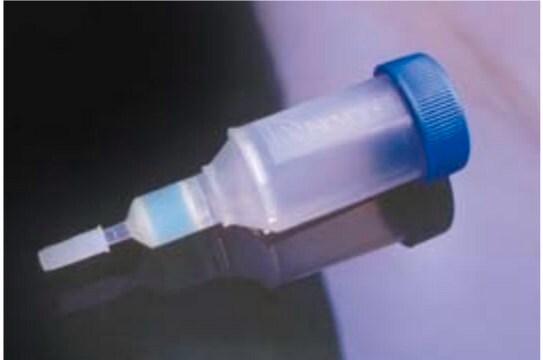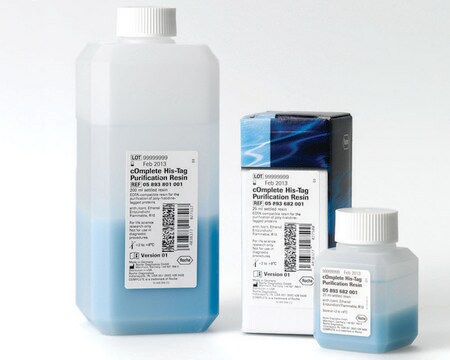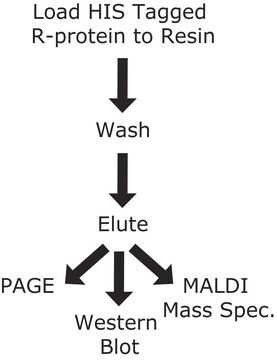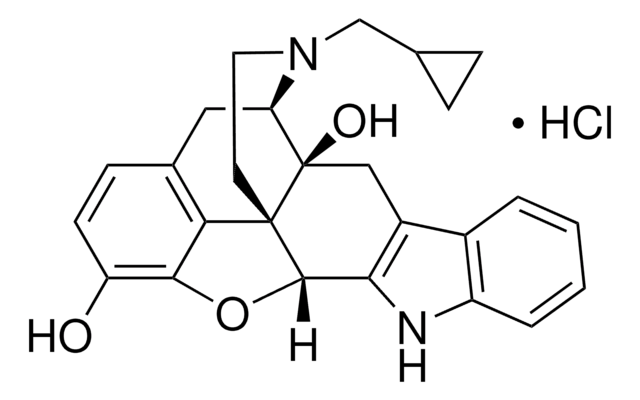Kluczowe dokumenty
P6611
HIS-Select® Nickel Affinity Gel
(1:1 suspension in a 20% ethanol solution)
Synonim(y):
Ni-NTA resin, nickel charged agarose
About This Item
Polecane produkty
białko sprzężone
magnetic beads
Poziom jakości
Postać
(1:1 suspension in a 20% ethanol solution)
Właściwości
hydrophilic
opakowanie
pkg of 1 mL
pkg of 100 mL
pkg of 25 mL
pkg of 5 mL
pkg of 500 mL
stężenie
1.5-2.4 mL/mL (suspension in packed gel)
metody
protein purification: suitable
kolor
faint blue to very dark blue
macierz
6% Beaded Agarose
pojemność
>15 mg/mL, gel binding capacity (protein)(with an approx. 30 kDa protein)
temp. przejścia
flash point 32 °C (closed cup)
temp. przechowywania
2-8°C
Opis ogólny
Zastosowanie
Cechy i korzyści
- High selectivity for higher purity.
- Unique non-charged hydrophilic linkage reduces non-specific binding.
- Binding capacity for histidine-tagged protein is greater than 15 mg/mL.
- Binding under denaturing or non-denaturing conditions.
- One-step purification.
- Minimizes unwanted ionic interactions.
- Minimal nickel leaching.
- Bead size: 45-165 μm.
Powiązanie
Postać fizyczna
Przechowywanie i stabilność
Informacje prawne
produkt powiązany
Hasło ostrzegawcze
Warning
Zwroty wskazujące rodzaj zagrożenia
Zwroty wskazujące środki ostrożności
Klasyfikacja zagrożeń
Flam. Liq. 3
Kod klasy składowania
3 - Flammable liquids
Klasa zagrożenia wodnego (WGK)
WGK 3
Temperatura zapłonu (°F)
89.6 °F - closed cup
Temperatura zapłonu (°C)
32 °C - closed cup
Certyfikaty analizy (CoA)
Poszukaj Certyfikaty analizy (CoA), wpisując numer partii/serii produktów. Numery serii i partii można znaleźć na etykiecie produktu po słowach „seria” lub „partia”.
Masz już ten produkt?
Dokumenty związane z niedawno zakupionymi produktami zostały zamieszczone w Bibliotece dokumentów.
Klienci oglądali również te produkty
Powiązane treści
Techniki oczyszczania białek, odczynniki i protokoły oczyszczania rekombinowanych białek przy użyciu metod obejmujących wymianę jonową, wykluczenie wielkości i chromatografię powinowactwa białek.
Techniki oczyszczania białek, odczynniki i protokoły oczyszczania rekombinowanych białek przy użyciu metod obejmujących wymianę jonową, wykluczenie wielkości i chromatografię powinowactwa białek.
Protein purification techniques, reagents, and protocols for purifying recombinant proteins using methods including, ion-exchange, size-exclusion, and protein affinity chromatography.
Protein expression technologies for expressing recombinant proteins in E. coli, insect, yeast, and mammalian expression systems for fundamental research and the support of therapeutics and vaccine production.
Nasz zespół naukowców ma doświadczenie we wszystkich obszarach badań, w tym w naukach przyrodniczych, materiałoznawstwie, syntezie chemicznej, chromatografii, analityce i wielu innych dziedzinach.
Skontaktuj się z zespołem ds. pomocy technicznej









